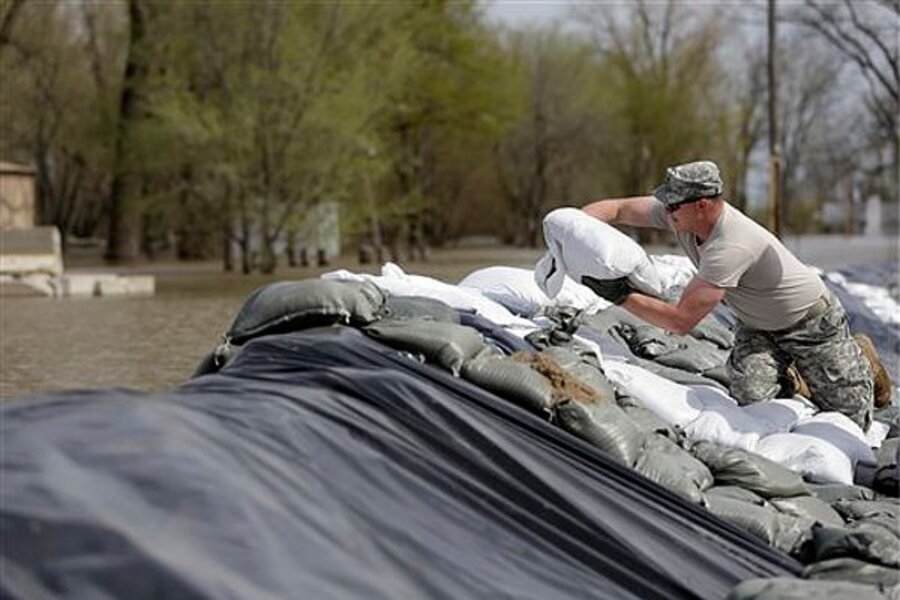Along the Mississippi, river views trump flood protection
Loading...
| CLARKSVILLE, Mo.
Her Missouri hamlet soon to celebrate its 200th birthday, Mayor Jo Anne Smiley embraces Clarksville's perilous place along the Mississippi River, never mind that that the waters again threaten to wipe it and its potpourri of specialty shops off the map.
In places like Clarksville and the Illinois town of Grafton just across the river, it's always been the clear views of the Mississippi drawing the tourists, unobstructed by a permanent levee. But that's left both communities north of St. Louis vulnerable.
By Monday, the rain-swollen river strained a hastily erected makeshift floodwall in Clarksville, creating two trouble spots that volunteers were scrambling to patch — as well as build a second sandbag wall to catch any water weaseling through.
But though the Mighty Mississippi is starting to recede, another batch of rain threatens to push it back up. A swath from Oklahoma through Michigan is forecast to get an inch of rain — in some cases slightly more — through Tuesday. The National Weather Service said some river levels again could rise, blunting their slow retreat.
Mark Fuchs, a National Weather Service hydrologist, said the latest dousing could be especially troubling for communities along the Illinois River, which he said is headed for record crests.
"Along the Illinois, any increase is going to be cause for alarm, adding to their uncertainty and, in some cases, misery," he said late Monday afternoon.
Last week's downpours brought on sudden flooding throughout the Midwest, and high water is blamed for at least three deaths. Authorities in LaSalle, Ill., spent Monday searching for a woman whose van was spotted days earlier near a bridge over the flooded Illinois, and a 12-year-old boy was in critical condition after being pulled from the Big River near Leadwood, Mo., about 65 miles south of St. Louis, after floodwaters swept him away as he tried to walk across a bridge.
Flooding along the Mississippi doesn't have the impact today that it had during the Great Flood of 1993. Since then, thousands of homes have been bought out, so the flood plain in many places is largely green space. Other places have built better flood walls and levees.
But in flood-prone Clarksville, putting up permanent protection against the river is a non-starter, partly because it could cost millions of dollars the 442-person community can ill-afford without plenty of taxpayer help.
More importantly, Smiley and others say, building a flood wall would amount to sacrificing Clarksville's identity.
"The Mississippi River is out there, and we live on it," Smiley said in the town where 6,000 tons of sand has been crafted into the latest makeshift wall by locals, the National Guard and even prison inmates. "We are a tourist town, and part of that involves seeing and experiencing the river."
The hamlet is currently working with the Army Corps of Engineers on a master flood plan, and Smiley said one option involves buying a metallic, interlocking flood wall that doesn't require sand and can go up fast in a flood event. But that approach is expensive: A mile-and-a-half stretch would cost millions of dollars, not to mention the money needed for equipment to move it and places to store it.
Smiley and her Grafton counterpart, Tom Thompson, say erecting a levee could cause headaches for property owners by dispersing the water onto their land, much of it fields. But they acknowledge those concerns are secondary to the central objection — levees block river views.
"We feel the way we handle these floods is acceptable to us," Thompson said Monday from his 670-person town where the Mississippi was 10 feet above flood stage, swamping some basements and forcing lower-lying businesses in the kitschy downtown to close until the water recedes.
"There's no desire for a levee, and we would fight that," Thompson said.
Grafton resident Pam Bick, 57, echoed Thompson's disdain, even as her basement was taking in water by the minute Monday.
When it comes to flooding, "we just live with it," Bick said. She and her husband have lived in the home for four decades, including in 1993, which left water halfway up the structure's entry level. "We're resilient, and we live here because it's so beautiful."
Spots south of St. Louis aren't expected to crest until late this week, and significant flooding is possible in places like Ste. Genevieve, Mo., Cape Girardeau, Mo., and Cairo, Ill. On Monday, flood warnings were issued for Kentucky and Tennessee, but officials say the high water shouldn't make a significant impact.
Residents of tiny Dutchtown, Mo., south of Cape Girardeau, were filling thousands of sandbags to protect their homes.
"We've had our houses under water more than once out here," town board chairman Bud Smith told the Southeast Missourian. "We're trying to get a buyout, but you know how slow the government moves."
Elsewhere, smaller rivers were continuing to cause big problems. In Grand Rapids, Mich., the Grand River crested Sunday at a record 21.85 feet, driving hundreds of people from their homes and flooding parts of downtown.
The flooding also created some odd scenes. In Fox Lake, Ill., carp from the swollen Fox River were seen swimming on driveways.
And near St. Louis, all 114 barges that broke loose over the weekend were accounted for. U.S. Coast Guard Lt. Colin Fogarty said 11 sank and the river will remain closed over a 15-mile stretch out of safety concerns. It wasn't clear when the river would be allowed to reopen.
River views trump permanent flood protection







